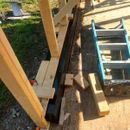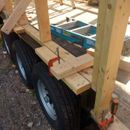Tiny house insulation detail
Hey there!
I’m building a 24′ tiny house on wheels and am looking for support on an insulation detail around the wheel wells. Pictures are attached from outside and inside. They are metal fenders that protrude into the living space, past the wall framing.
I live in southern Vermont, which means come winter it’ll be a cold spot in the envelope and my concern is how to deal with insulating it and where condensation might occur. All of the research I’ve done shows people framing them out on the inside and then using some kind of insulation in the framing to handle the cold spot. While this seems straightforward, I’m wondering if that means that between the metal and the insulation, where cold meets warm, there will be condensation, which is inside the house envelope and will drip down onto the plywood subfloor, leading to rot over time.
Is my understanding of the condensation location correct? If so, does anyone have suggestions on ways to insulate this location?
Thanks in advance!
Moses
GBA Detail Library
A collection of one thousand construction details organized by climate and house part











Replies
Moses,
The best type of insulation for this location is closed-cell spray foam (since closed-cell spray foam is an air barrier, a vapor barrier, and an insulating material).
After you install framing (a box) around the area -- leaving room for at least 3 inches of spray foam -- use a two-component spray foam kit to install insulation against the steel components.
A two-part foam kit uses a "blowing agent" that has extremely high global warming impact. It's hard to find an alternative for this application, but some options are:
1. Get a professional to foam it using new spray foam that uses an "HFO" blowing agent, which doens't have the global warming impact.
2. Use the "cut and cobble" method of insulating, using foam board with low global warming impact, such as EPS or Polyiso (not XPS), and meticulously seal the seams between boards.
Thanks Martin & Charlie for taking the time to respond!
That clarifies my question and gives me options to deal with that spot properly.
Regards
Moses
I'm curious - are all joints glued and screwed for increased strength? I'd also imagine that tiny houses should be built to the highest earthquake and hurricane standards.